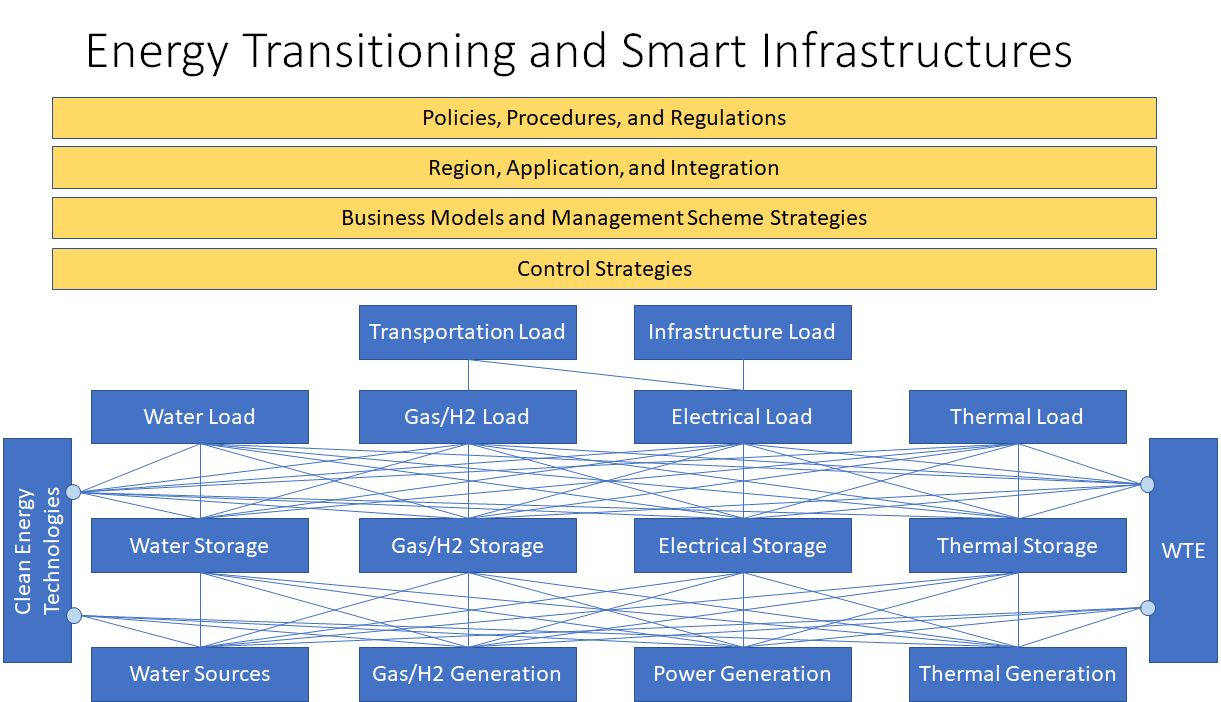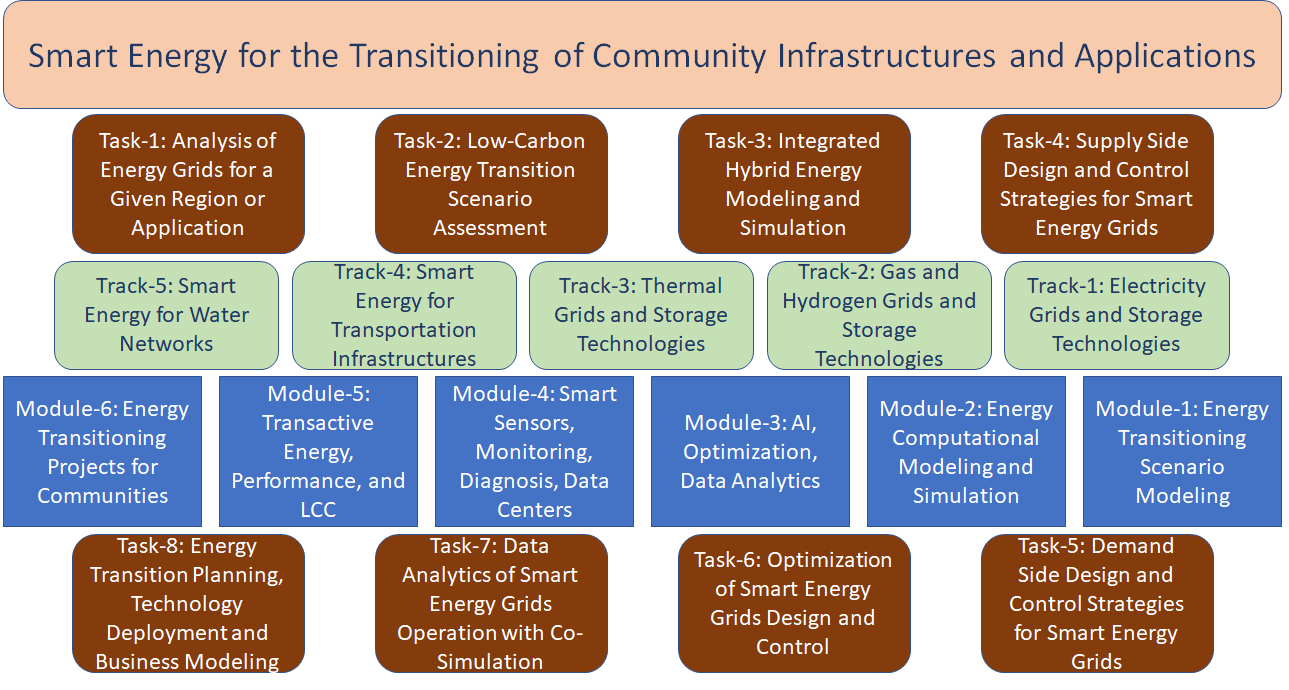Smart Energy and Transitioning of Community Infrastructures and Applications
Written by Hossam A. Gabbar
Canada and worldwide are experiencing climate and environmental changes and economical stresses in addition to the evolvement of energy technologies. These factors motivated governments, municipalities, companies, and public to seek suitable energy transition strategies with effective deployment plans. There strategies are directed towards smart energy in smart cities [1].
Current energy systems, engineering practices, and management schemes are rigid and are not supporting such transitioning. There are possible links between energy, water, transportation, waste, food, and other social factors [2]. The transitioning is based on number of factors, including the integration of renewable energy resources [3]. The typical integrated energy systems could be implemented as centralized or centralized models, which should be evaluated based on available resources and regional nature [4]. In addition, it is important to achieve optimized performance via analysis of different design and operation strategies [5]. This short paper discusses a proposal for the integration of various scenarios that should be considered as part of the transitioning into smart energy with integrated energy services such as electricity, thermal, gas supply and storage, with other elements in community such as water, waste, and transportation infrastructures. It is important to ensure the participation from the community to decide suitable energy management schemes and structures according to the needs. This is difficult in some situations, which caused challenges to support smooth transitioning. To ensure successful implementation of the transitioning plans, it is essential to ensure collaboration among researchers from different universities around the world to support complementary research areas and objectives. In addition, the integrated research team will support the training of personal to lead the successful energy transitioning and present it as a model for worldwide deployment and education. The proposed approach will prepare future generation engineers with essential skills through research and education training that covers analysis of energy demand, supply, evaluation of energy systems in view of performance measures, using modeling and simulation, as well as integration of real time data to synthesize possible low-carbon transition scenarios with associated control strategies and deployment and management schemes. The proposed approach includes integrated modeling and simulation of electrical, thermal, and gas networks, loads, storage, and technologies, as linked with energy, transportation, water, and community infrastructures. The different energy conversion and storage scenarios are evaluated within the specified energy system in view of performance measures and associated factors such as demand profiles, energy cost, weather, energy resources availability, and policies and regulations. The synthesis of energy scenarios is evaluated for both the design and operation of target hybrid energy systems, and used to specify effective management and planning schemes. In order to achieve accurate evaluation of transitioning scenarios, training will be conducted on developing smart interfaces between energy systems and technologies to integrate real data from energy systems with simulation models and environment to achieve accurate energy models to evaluate all possible energy transition scenarios and define the most suitable deployment plans. Also, the training will include Artificial Intelligence (AI) algorithms and data analytics techniques to support intelligent modeling and simulation and evaluation of energy transitioning scenarios. The estimated losses of wrong energy deployment strategies or delayed deployment projects are in the order of millions of dollars in each region. The proposed approach will support the selection of the right energy technologies, design configuration, operation and control strategies, as well will be integrate energy policies and regulations and other constraints as part of integrated intelligent modeling and simulation of hybrid energy systems.
In order to achieve the stated objectives, the training program is divided into five tracks: Track-1: electricity grids and storage technologies; Track-2: gas and hydrogen grids and storage technologies; Track-3: thermal grids and storage technologies; Track-4: smart energy for transportation infrastructures; and Track-5: smart energy for water networks. The program will also include working modules: Module-1: energy transitioning scenario modeling; Module-2: energy computational modeling and simulation; AI, optimization, and data analytics; Module-4: smart sensors, monitoring, diagnosis, and data centers; Module-5: transactive energy, performance, and LCC; and Module-6: Energy Transitioning Projects for Communities. The proposed tracks will be covered by the different modules, which will be offered by individual professors, so that personal will spend session in each module to learn all skills in each module and move to next module. In this way, all personal in all collaborative labs will get the chance to learn all essential skills with strong intercommunications among personal and different professors as well as the associated industries with each lab and module. The proposed approach will enable personal to acquire best practices to synthesize energy transitioning scenarios for different applications, including buildings, industrial facilities, fast charging stations, marine transportation, recreational facilities, waterfront regions, and other applications to support community systems and smart cities. The skills will enable engineers to practice the use of performance measures for the evaluation of the design and operation of hybrid energy systems using integrated modeling and simulation. The use of data analytics will support the design, control, operation, and planning of energy systems in different applications and levels. Fig. 1 shows the proposed approach for energy transitioning, which involves policies, regional management, business models, control strategies, and energy chart. Energy chart includes loads, storage, transfer, generation, and conversion for electricity/power, thermal, gas and hydrogen (H2), as integrated with water and transportation. This requires hybrid energy modeling and simulation to support smart energy grid engineering. The training will provide skills related to analysis of energy grids, transitioning scenario synthesis, modeling and simulation, energy supply strategies, demand side strategies, optimization of design and control strategies, data analytics with co-simulation, smart energy technology deployment and business modeling, and management schemes for effective transitioning.

Fig. 1: Smart Infrastructures for Energy Transitioning
The proposed framework offers new and novel approach to synthesize different energy transitioning scenarios and analyze them in view of real time data, integrated modeling and simulation, energy technology assessment, AI and data analytics, as well as energy policies and constraints. Fig. 2 shows possible transitioning framework. The proposed approach will enable all personal in each lab to receive advanced and focused training in all other labs with other professors and personal to gain integrated set of skills to enable them to lead effective energy transitioning with accurate results and reduced risks. The development of future energy leaders will prepare knowledgeable and skilled personal in different smart energy technologies and applications. The interfaces between modules and tracks will cover vertical and horizontal coverage of smart energy grids. Quality controls will be implemented in the form of training form, with evaluation criteria and assessment to ensure that all personal have received the detailed training and gained the required skills. Due to COVID-19, the interactions will be via online and remote communications. There will be annual workshop session for all personal from all modules and tracks and labs to participate and share the experience gained and knowledge acquired.

Fig. 2: Framework for Energy Transitioning
References
- H. Lund, P. A. Østergaard, D. Connolly, B. V. Mathiesen, Smart energy and smart energy systems, Energy, Volume 137, October 2017, Pages 556-565.
- Hossam A.Gabbar, Modeling of Interconnected Infrastructures with Unified Interface Design toward Smart Cities, Energies 2021, 14(15), 4572; https://doi.org/10.3390/en14154572.
- O. Erdinc, M. Uzunoglu, Optimum design of hybrid renewable energy systems: Overview of different approaches, Renewable and Sustainable Energy Reviews, 16 (2012) 1412–1425.
- T. Levina, V. M. Thomas, Least-cost network evaluation of centralized and decentralized contributions to global electrification, Energy Policy 41 (2012) 286–302.
- T. Ma, J. Wu, L. Hao, W. Lee, H. Yan, D. Li, The optimal structure planning and energy management strategies of smart multi energy systems, Energy, Volume 160, October 2018, Pages 122-141.
This article edited by Gabriel Ordoñez
For a downloadable copy of the October 2021 eNewsletter which includes this article, please visit the IEEE Smart Grid Resource Center.

To have the Bulletin delivered monthly to your inbox, join the IEEE Smart Grid Community.
Past Issues
To view archived articles, and issues, which deliver rich insight into the forces shaping the future of the smart grid. Older Bulletins (formerly eNewsletter) can be found here. To download full issues, visit the publications section of the IEEE Smart Grid Resource Center.




